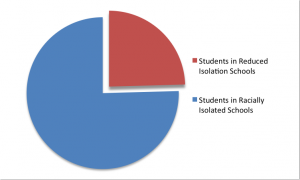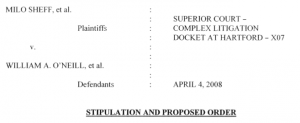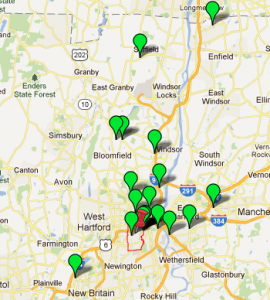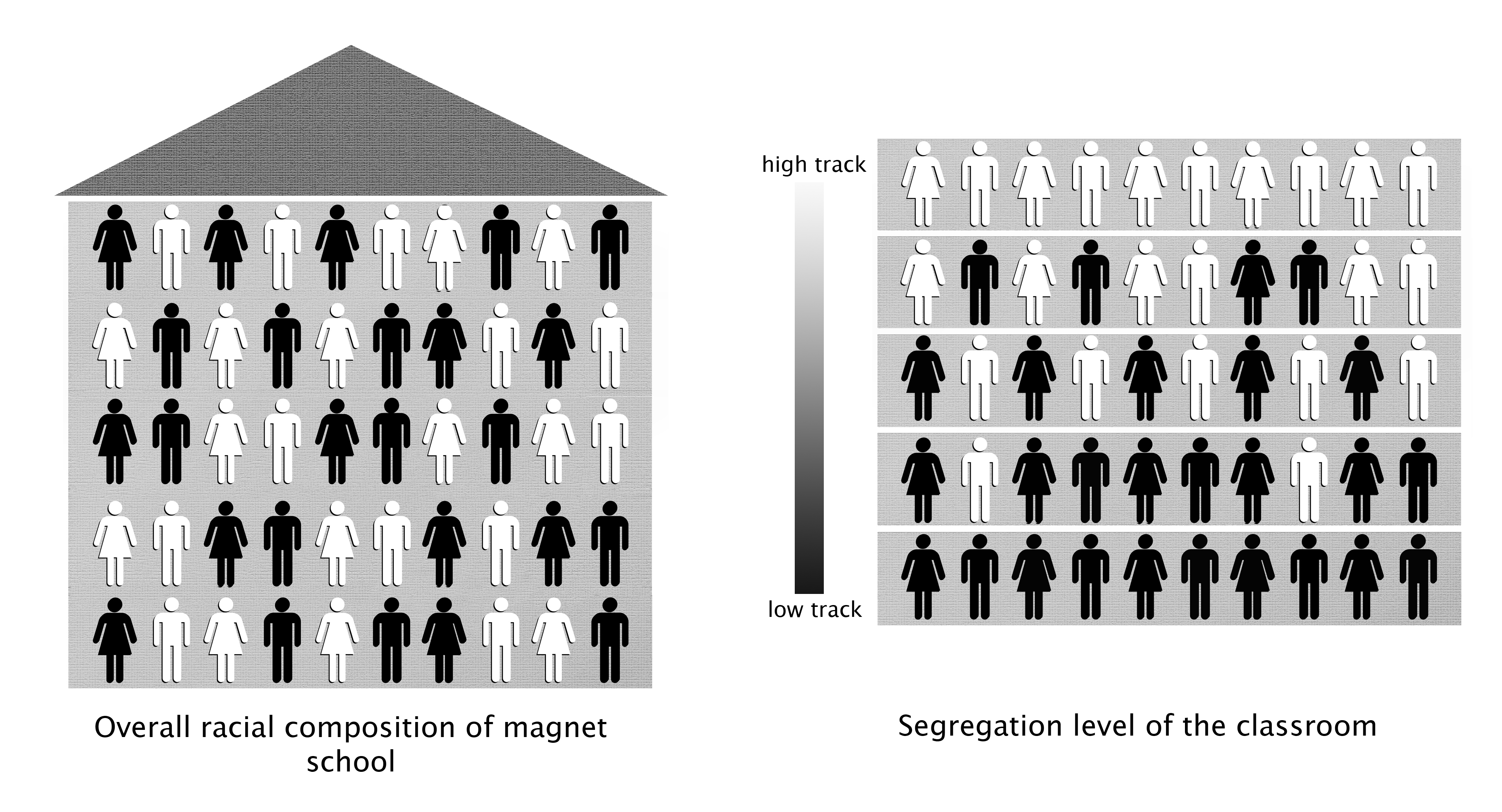Desegregated Schools with Segregated Classrooms
The Reality of Racialized Tracking at Magnet Schools
Introduction
Over the past decades, politicians, civil rights leaders, and community organizers have worked to give every Hartford child the opportunity to attend a racially and socioeconomically integrated school. Sheff v. O’Neill is a landmark civil rights lawsuit filed by Elizabeth Horton Sheff and other parents against then-Governor William O’Neill in 1989, claiming that the severe racial and socioeconomic isolation of Hartford school children violated the state’s constitution. However, this situation is not unique to Hartford. The Sheff case has implications for the dynamic between urban and suburban disparities nationally. The de facto segregation that the lawyers argue is to blame for the poor educational opportunities of Hartford students is, in fact, pervasive in nearly every city nationwide. All students stand to benefit from more racially integrated schools.
One aspect of the settlement, the creation of inter-district magnet schools, serves as one of the strongest means of remedying racial segregation in public schools, by bringing together children from both suburban towns and the city. “Magnet schools may very well be effective tools for desegregating at the building level. However, magnet schools may exacerbate or even cause within-school segregation.” 1 The goal of Sheff v. O’Neill is to promote desegregated schools. However its measure of desegregation is incomplete. Desegregation measured only at the school level does not indicate segregation at the classroom level. Put simply, while an overall school may be technically desegregated, individual classrooms can remain highly segregated virtually eliminating any benefit of desegregation. “By definition, it is paradoxical to attach the label ‘desegregated’ to a magnet school that operates segregated classrooms. Nevertheless, the commonly accepted definition of desegregation permits a magnet school with racially segregated classrooms to be deemed desegregated.” 1 We argue that the state should create a more effective definition of desegregation that includes not only the overall school but also the classroom level. The state needs to addresses racialized tracking in desegregation efforts.
Sheff v. O’Neill
Sheff plaintiffs advocated for the State of Connecticut to uphold the constitutional rights of children in Hartford schools to equal opportunity. They argued that the Connecticut’s districting system based upon city and suburban boundary lines led to racially segregated schools. 3 “Hartford Public Schools’ population consisted of 91 percent minority students, surrounded by suburban district comprised of 88 percent white students.” 4 Although in 1996, the State Supreme Court ruled in favor of Sheff plaintiffs, “the Court did not specify a goal, remedy, or timetable to resolve the problem, stating that this responsibility belonged to the legislative and executive branches.” 5

In 2003, the Sheff v. O’Neill reached to an agreement, to provide at least 30 percent of public school minority students with an educational experience with reduced isolation by using interdistrict magnet schools, the Open Choice program, and interdistrict cooperative programs. 3 Moreover, the agreement required the state to open and maintain two new interdistrict magnet schools in Hartford per year. Even though the state was pressured to take actions to alleviate the violation, this goal is not directly enforceable. Four years later, the goal was only met with approximately 10% of students attending less racially isolated schools. 5

Since the state failed to make significant progress towards the goal (Sheff I), the plaintiffs returned to Court several times and lead a discussion on a second settlement. The Sheff plaintiffs claimed that the State was not doing enough to fill new magnet schools to capacity, declaring the state’s efforts to integrate Hartford students inadequate. Thus, the plaintiffs saw very little progress made by the state. On the other hand, the State “responds that it has complied with the settlement by opening two magnet schools per year, while phasing in grade levels as planned.” 8 The State managed to create 22 interdistrict magnet schools and enrolled 1,000 minority Hartford children in suburban schools. Both parties expressed common interest in increasing the racial, ethnic, and economic integration of Hartford Public School students.
Under the current settlement agreement (Sheff II), the plaintiffs requested more magnets schools to be built and increasing the number of seats for Hartford children in suburban public schools. In addition, the state and the plaintiffs agreed to achieve at least 35% of Hartford minority children have access to racially integrated schools by 2010-11 and 41% by 2013.
Check out the original 1989 complaint here!
The Magnet School
What are magnet schools? What is its role in public education?

Magnet schools are public schools – they are tuition free schools that serve many different populations. Magnet schools are bureaucratically part of the public school system, which makes them different than private or charter schools. Public school districts oversee magnet schools. In some cases, however, inter-district magnet schools are operated by a separate system, like the schools part of the Capitol Region Education Council in Hartford that are managed by the Regional School Choice Office. Parents must apply for admission to magnet schools, which is frequently awarded through a lottery process. Inter-district magnet schools are financed through a mixture of state and local funds with certain schools receiving income from various federal or private sources. The bulk of operating costs, however, are covered through state allocation and the tuition the magnet school charges a student’s home district.

Magnet schools are different than zoned neighborhood public schools for in two respects. The first difference is the curriculum they offer. Magnet schools are not necessarily academically better than regular public schools; rather, magnet schools are able to offer more focused or unusual curricular offerings. For example, magnet schools in Hartford include the Greater Hartford Academy of Performing Arts and the University High of Science and Engineering, among others. The second difference is the student population magnet schools serve. Inter-district magnet schools enroll students across school district and town boundaries. Consequently, magnet schools generally have more diverse populations in terms of both race and socioeconomic status than zoned public schools.
Higher socioeconomic diversity and more specialized curriculum are benefits of magnet schools. There are, however, multiple drawbacks. Magnet schools are not neighborhood schools. Students sometime travel considerable distances to their magnet schools. If the distance along isn’t enough, the community dynamic present at a magnet school can be different than that at a zoned neighborhood school. This is not to imply it is worse, rather only that it is different. Also, unlike regular public schools, admission to magnet school is not guaranteed. Admission is based on academic merit or lottery. For example, in Hartford where admission is lottery based, a parent could apply to several inter-district magnet school but be accepted to none. Because of widespread popularity certain schools have large numbers of applications limiting acceptance to only a lucky few. Magnet schools are not without their faults and are not guaranteed to successfully create desegregation.
Tracking
Jeanie Oakes argues that there is a strong relationship between race or ethnicity and tracking as well as indirectly related to other socioeconomic characteristics. Her research found “the predominant pattern in racial composition, with disproportionately large percentages of white students in high-track classes and of nonwhite students in low-track classes.” 9 Her studies illustrate “classroom segregation does exist in many schools that are racially balanced at the building level…and evidence suggests that magnet schools often operate racially imbalanced classes”. 1 Minority students are over-enrolled in basic or remedial classes because of racialized tracking policies.
“The two factors repeatedly identified as causing classroom segregation within otherwise desegregated buildings are (1) methods of assigning students to academic programs, such as tracking, ability grouping, and remedial pull-out programs and (2) disciplinary practices that discriminate against minority students”. 1 There are differences in the quality of the educational experiences in different track levels. Disproportionately large percentages of poor and minority students are more likely to be placed in low-track classes. They benefit least from schooling and receive a poorer quality of educational experience in classrooms. On the other hand, affluent white middle and upper class students are more likely to be placed in the high-track classes and receive better quality instructions. High track classes prepare students for success in college academic work, while the low-track classes prepare students low occupational level jobs. As a result of students in different track levels being exposed to different material, nonwhite students do not have the same opportunities to learn the same content as the white students. This creates inequality in the distribution of knowledge.
We propose schools to practice detracking in the classrooms. Detracking is a response to remedy the inequalities caused by tracking. We are not arguing that tracking itself is the problem. Rather, we argue the problem is the failure to effectively address the strong correlation between race and academic track in school desegregation policies. “In detracked setting, educators intentionally group student heterogeneously, balancing groups in terms of race, gender, and academic ability.” 12 When classes are detracked, students from various backgrounds are brought together. As a result, it breaks down socioeconomic barriers and allows students to benefit from one another academically. Low-track students are given the opportunities to develop academic skills, while white students’ preconceptions and stereotypes about minority students’ abilities are diminished. To provide a better education for all, classes should be detracked. Consequently, detracking is a reform that would help lessen the academic disparities among low-income and minority students.
What We Know and What We Don’t
Each year, the State of Connecticut publishes strategic district and individual school profiles. Each district and every public K-12 school is included. Click here to see a sample school profile: HMMS Strategic School Profile (2009-2010). This information is all publically available on the CT State Department of Education. The school profiles provide a wealth of specific information, including racial demographics, testing performance, total hours of instruction time, along with many other quality indicators. However, references to tracking are absent from the report. Much of this is following No Child Left Behind (NCLB) regulations that require enrollment and school testing data be disaggregated according to gender, major racial and ethnic groups, disability, English proficiency, and economic status. NCLB addresses the fact that historically, the academic progress of limited English proficient students and certain minority groups was inadequate. Because performance data was only assessed previously at the school-wide level, variations among subgroups remained hidden (1). Although this stipulation of NCLB has had significant impact on awareness of educational disparities, it only requires that schools disaggregate testing data. It does not require schools address other forms of racial disparities within the school environment, such as tracking.
The Sheff v. O’Neill settlement set guidelines for school desegregation. The case legally defined desegregation, which now defined as no more that 75% minority students. However, even when combined with the previously discussed NCLB testing standards this percentage enrollment does not sufficiently address tracking patterns within school. Schools do not officially report racial demographics of the different academic tracks. Although through ethnographic data and other academic research it is recognized that minority students are disproportionally placed in low-track classes, there is minimal state or district wide data on this subject. Searching through the CT Department of Education website, individual district or school pages, and CEDaR (the CT government database for education statistics and research) yields no specific information. While a school may be considered desegregated and report testing differences among historically under performing subgroups, we have no information regarding racial demographics within the classrooms. Put simply, we have no widespread statistical data regarding school tracking.
Conclusion
The Sheff plaintiff measures its goal of integrated schools by having the state meet at least 30% of Hartford minority public students educated in racially integrated settings, which is defined as having a student population that is no more than 75% minority. According to the case, “reduced-isolation setting refers to an educational setting with reduced racial, ethnic, and economic isolation”. Schools “provide a reduced-isolation setting if its enrollment is such that the percentage of minority students in the school does not exceed the Desegregation Standard.” 13 Simply, schools can be labeled reduced isolation settings without acknowledging academic disparities within the school. As long as the school meets the enrollment percentage the school is considered desegregated. However, how can true desegregation and equal opportunity be defined using only a simple numerical standard?
We believe that measuring desegregation only at the overall school level is ineffective because it does not provide insight into intra-school policies or practices. Minority students enrolled in a magnet school meeting Sheff desegregation guidelines may in fact be racially isolated within the school because of tracking practices. It is not enough to just evaluate the level of desegregation based on the calculated percentage of Hartford minority students who were enrolled in magnet schools. We argue that court’s definition of desegregation should apply to classrooms as well as schools. In order to analyze effectiveness of desegregation, there needs to data on classroom racial balance. “Nevertheless, because academics have failed to evaluate desegregation plans in terms of their success in eliminating within-school segregation, magnet schools have been deemed effective desegregation tools”. 1 Although we realize that school desegregation is an enormously complex and highly politicized issue, we believe that more can be done with respect to how desegregation is defined at the policy level. Future legislative goals should incorporate the racial composition of the classrooms to more fully ensure that students are receiving an integrated education. Requiring racially integrated classrooms is necessary to bridge the educational disparities between cities and suburbs.
If you are interested in more information about the Sheff Movement or magnet schools, we encourage you to visit the links below:
About the Authors
Pornpat Pootinath is a sophomore at Trinity College, CT majoring in Educational Studies and Sociology. She serves as an academic facilitator at Hartford Magnet Trinity College Academy and teaches ninth-grade mathematics. On campus, she is a resident assistant, teaching assistant, public relations of AASA, and an active member of Stop the Raids.
Nathan Walsh is a senior Educational Studies Major at Trinity College. His academic interests include urban education reform and the role of public education as a tool for social change.
- Kimberly West. “A Desegregation Tool That Backfired: Magnet Schools and Classroom Segregation.” The Yale Law Journal, Vol. 103, No. 8, Symposium: The Informal Economy (Jun., 1994): 2567. http://www.jstor.org/stable/797056. ↩
- Kimberly West. “A Desegregation Tool That Backfired: Magnet Schools and Classroom Segregation.” The Yale Law Journal, Vol. 103, No. 8, Symposium: The Informal Economy (Jun., 1994): 2567. http://www.jstor.org/stable/797056. ↩
- “Sheff Movement: Quality Integrated Education for All Children” http://www.sheffmovement.org/index.shtml. ↩
- Jack Dougherty, Christina Ramsay, and Jesse Wanzer, “Sheff v. O’Neill: Weak Desegregation Remedies and Strong Disincentives in Connecticut, 1996-2008,” in From the Courtroom to the Classroom: The Shifting Landscape of School Desegregation, ed. Claire Smrekar, and Ellen Goldring (Cambridge, MA: Harvard Education Press, 2009). ↩
- “Sheff Movement: Quality Integrated Education for All Children” http://www.sheffmovement.org/index.shtml. ↩
- “Sheff Movement: Quality Integrated Education for All Children” http://www.sheffmovement.org/index.shtml. ↩
- “Sheff Movement: Quality Integrated Education for All Children” http://www.sheffmovement.org/index.shtml. ↩
- “Sheff Movement: Quality Integrated Education for All Children” http://www.sheffmovement.org/index.shtml. ↩
- Jeanie Oakes. Keeping Track: How Schools Structure Inequality (New Haven: Yale University Press, 1985). ↩
- Kimberly West. “A Desegregation Tool That Backfired: Magnet Schools and Classroom Segregation.” The Yale Law Journal, Vol. 103, No. 8, Symposium: The Informal Economy (Jun., 1994): 2567. http://www.jstor.org/stable/797056. ↩
- Kimberly West. “A Desegregation Tool That Backfired: Magnet Schools and Classroom Segregation.” The Yale Law Journal, Vol. 103, No. 8, Symposium: The Informal Economy (Jun., 1994): 2567. http://www.jstor.org/stable/797056. ↩
- Mica Pollock. Everyday Antiracism: Getting Real about Race in School (New York: New, 2008). ↩
- Sheff v O’Neill, Stipulation and Proposed Order, Connecticut Superior Court, April 4, 2008, available from The Sheff Movement website, http://www.sheffmovement.org/pdf/SheffPhaseIIStipandOrder.pdf ↩
- Kimberly West. “A Desegregation Tool That Backfired: Magnet Schools and Classroom Segregation.” The Yale Law Journal, Vol. 103, No. 8, Symposium: The Informal Economy (Jun., 1994): 2567. http://www.jstor.org/stable/797056. ↩



1. Does the web project present a clear and compelling story about an important aspect of cities, suburbs, and schools? Does it inspire the reader to think about the topic in a new way?
You present a concise and well informed view of the Sheff case. You raise some important points; the introduction of magnet schools may attempt to reduce desegregation at the district/school level, but they don’t seem to address integration at the classroom level. Desegregation efforts do not take into account persistent negative practices, like tracking, imbedded in the public school system. However, ruling desegregation, at the school/classroom level, as the means to achieve better schools with integrated classrooms where children can thrive and learn, fails to recognize other forces working against students outside the realm of the school. I do agree it would make it easier for teachers and students, but I wonder what a longitudinal study would show?
2. Is the reasoning persuasive and well developed? Are the claims supported with appropriate evidence? Is counter-evidence fully considered?
There are no studies documenting tracking in Hartford P.S. or Magnet schools out there, is it realistic to expect policy makers, superintendents, education commissioners and others, who may be skeptical, to address a problem that may be viewed as an unconfirmed occurrence?
3. Does the web project make effective use of the online format by integrating narrative text with digital elements (such as maps, charts, photos, videos, and online source materials)? Are all digital elements credited?
Yes. You may also want to include a website that includes parents’ opinions on this topic. Achieve Hartford, has publications regarding parent involvement. The graphics included—particularly the pie charts—would benefit from having numbers included directly on or next to the graphic for clarification.
4. Is the writing well organized with smooth transitions between focused paragraphs? Does it include sufficient background for audiences unfamiliar with the topic? Yes. The project is well-outlined and easy to follow with the formatting of the webpage.
5. Did the author(s) choose precise and meaningful wording, with fluent syntax and correct grammar and spelling? Yes.
6. Did the author(s) cite sources in a standard academic format (such as Chicago-style footnotes, or MLA/APA in-line citations with a bibliography) so that readers may easily locate them? Yes.